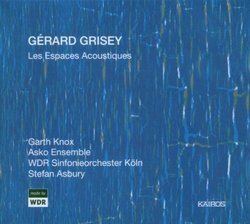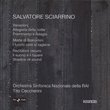| All Artists: Gerard Grisey, Stefan Asbury, Asko Ensemble, WDR Sinfonieorchester Köln, WDR Sinfonie Orchester Köln Title: Gérard Grisey: Les Espaces Acoustiques Members Wishing: 1 Total Copies: 0 Label: Kairos Release Date: 11/1/2008 Genre: Classical Styles: Chamber Music, Forms & Genres, Concertos, Historical Periods, Modern, 20th, & 21st Century Number of Discs: 2 SwapaCD Credits: 2 |
Search - Gerard Grisey, Stefan Asbury, Asko Ensemble :: Gérard Grisey: Les Espaces Acoustiques
 | Gerard Grisey, Stefan Asbury, Asko Ensemble Gérard Grisey: Les Espaces Acoustiques Genre: Classical
|
Larger Image |
CD DetailsSimilar CDs |
CD ReviewsThe spectral masterwork finally appears R. Hutchinson | a world ruled by fossil fuels and fossil minds | 12/13/2008 (5 out of 5 stars) "In avant circles the name Gerard Grisey holds mysterious power. Grisey, who died in 1998 at the age of 52, had created a new "school" (along with Tristan Murail) known as spectral music, but this school was more talked about than heard. Now Grisey's major work, "Les Espaces Acoustiques" (1974-85) is finally available -- actually on two recordings, the original late 1990s recording on Accord, the French label, now reissued, and this new Kairos recording with Stefan Asbury leading the Asko Ensemble and the WDR Sinfonieorchester Koln.
"Les Espaces" is in six parts which were originally written separately as stand-alone pieces, though there is a clear structure linking them together, and the full impact is only felt when it is played in its entirety. The opening ("Prologue" -- 15'28) is a solo for viola, played here by Garth Knox. Then follows "Periodes" (15'28) for seven musicians, and "Partiels" (22'02) for 18 musicians. The sound gradually expands, becoming lusher and more complex. The second disc consists of "Modulations" (16'10) for 33 musicians, followed by "Transitoires" (19'54) for large orchestra and "Epilogue" (8'03) for four horns and orchestra. "Modulations" has been recorded by Pierre Boulez and his Ensemble Intercontemporain, and was performed in May 2005 by the San Francisco Symphony Orchestra. I am not yet convinced by the "Epilogue." I tend to think that the ending of "Transitoires" makes a better ending to the overall work, though it is certainly less dramatic. The loud staccato horns just don't seem to mesh with all that has gone before. According to Grisey in the liner notes, "[t]he unity of the whole is based on the formal similarity of the pieces and on the two acoustic points of reference: the overtone spectrum and periodicity." He notes that the musical language includes "applying phenomena that have long been studied in electronic studios to the area of instrumental sound. These applications may be heard in their more radical forms in "Partiels" and "Modulations." I will not attempt a technical exegesis of the work. Grisey's notes and further commentary easily accessible on the web provide some basis for understanding "Les Espaces," as well as Grisey's "spectral" theory of sound. But I can say that it sounds fantastic! The closest thing to it is Ligeti's micropolyphony, so that gives you something to compare it to and judge whether you are likely to enjoy it or not. Grisay and Murail (see my review of Murail's Montaigne disc) developed spectral music in reaction against serialism, and their compositions definitely sound less like Boulez than Ligeti and sometimes Xenakis. "Les Espaces Acoustiques" is well worth hearing for anyone devoted to the late 20th century avant-garde -- this particular 2002 performance and recording is outstanding." |

 Track Listings (3) - Disc #1
Track Listings (3) - Disc #1


